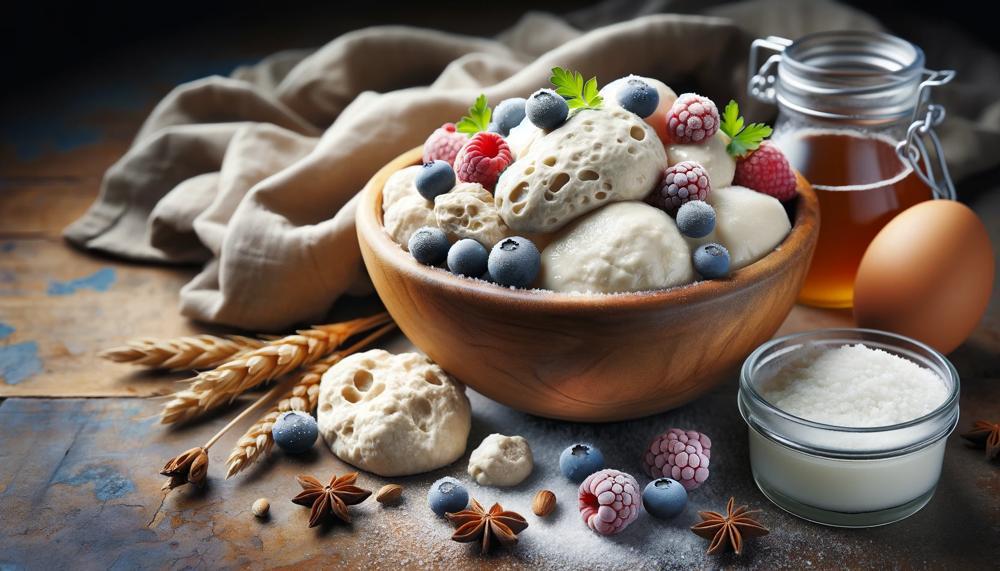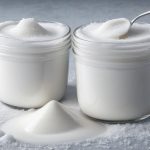Did you know that freezing fresh yeast can significantly extend its shelf life and potency for baking? While refrigeration can keep fresh yeast viable for up to two weeks, freezing takes it a step further, allowing you to store it for three months or even more. So, if you’re a baking enthusiast who wants to always have fresh yeast on hand, freezing is the solution you’ve been looking for.
Contents
Key Takeaways:
- Freezing fresh yeast can extend its shelf life for up to three months or more.
- Proper storage, such as tightly sealing it in a container and avoiding exposure to air and moisture, is crucial for freezing fresh yeast.
- Freezing fresh yeast slows down the metabolic activity of yeast cells and preserves their viability.
- The recommended temperature for freezing fresh yeast is between -10°C and -20°C (-14°F and -4°F).
- Thawing frozen yeast should be done slowly in the refrigerator to preserve its quality.
The Basics of Fresh Yeast and its Role in Baking
Fresh yeast, also known as baker’s yeast or cake yeast, is a living organism that is preferred by many bakers for its exceptional leavening properties. It is made up of living cells of Saccharomyces cerevisiae, a type of fungus commonly used in bread making.
Fresh yeast has a higher moisture content and delicate nature compared to other types of yeast. When combined with warm water or other liquids, it activates quickly and plays a crucial role in the fermentation process. This process is essential for giving baked goods their airy texture and contributes to their flavor and aroma.
Understanding the basics of fresh yeast is key to harnessing its full potential in baking, as it provides the necessary leavening properties that result in delicious, perfectly baked goods.
Can You Freeze Fresh Yeast?
Yes, you can freeze fresh yeast. Freezing yeast can help it last longer than storing it in the fridge or pantry. Fresh yeast can last in the fridge for about two weeks, and in the freezer for three months or more.
Here are some tips for freezing fresh yeast:
- Store in a sealed container
- Place in the fridge for at least 12 hours before freezing
- Keep in multiple layers of covering
- Twist into a ball the size of a golf-ball
- Keep it nice and loose so that it crumbles easily when you come to use it
You can also mix 12g of fresh yeast into a bowl containing about 30g of White Bread Flour. Then, use a fork or your fingers to mix it up into a dry crumbly mixture and put into a small plastic bag.
Before incorporating frozen yeast into your recipes, it’s important to test its viability. To activate frozen yeast, mix it with 100 milliliters of warm water and a small pinch of sugar. Leave it to proof as you would with non-frozen yeast.
The Science Behind Freezing Fresh Yeast
Freezing fresh yeast has a significant impact on yeast cells, affecting their metabolic activity and overall viability. While freezing preserves the yeast cells’ freshness, the process itself can cause some damage that may compromise their performance. Ice crystals can form within the cells during freezing, potentially disrupting their normal functioning.
To strike a balance between preservation and minimizing damage, it is recommended to freeze fresh yeast at temperatures between -10°C and -20°C (-14°F and -4°F). Freezing fresh yeast at temperatures outside this range can lead to more significant damage to the yeast cells, reducing their effectiveness in fermentation and leavening. However, it’s important to note that freezing fresh yeast is not a foolproof method, and the frozen yeast should be used within a reasonable timeframe.
The Process of Freezing and Thawing Fresh Yeast
When it comes to freezing fresh yeast for future use, proper handling and storage techniques are crucial. Here’s a step-by-step guide on how to freeze and thaw fresh yeast to maintain its viability and effectiveness.

- Divide and wrap: Begin by dividing the fresh yeast into smaller portions. This allows for easier portioning and thawing later on. Wrap each portion tightly in plastic wrap or place them in airtight containers to prevent freezer burn and contamination.
- Freeze at the right temperature: It is recommended to freeze fresh yeast at a consistent low temperature between -10°C and -20°C (-14°F and -4°F). This range ensures that the yeast maintains its freshness and viability throughout the freezing process.
- Thaw slowly: Thawing frozen yeast should be done slowly to preserve its quality and effectiveness. Place the wrapped or containerized yeast in the refrigerator and allow it to thaw gradually. Avoid using methods like microwave thawing or leaving it at room temperature, as they can lead to uneven thawing and potential loss of yeast potency.
- Test for viability: Once the yeast has thawed, it’s important to test its viability before using it in baking. To do this, dissolve a small portion of the thawed yeast in warm water (around 110°F) with a pinch of sugar. Let it sit undisturbed for 5-10 minutes. If the yeast becomes frothy and bubbles form, it indicates that the yeast is still viable and can be used for baking.
Following these freezing and thawing methods helps ensure that frozen yeast retains its effectiveness and can be reliably used for baking. Now that you know how to freeze and thaw fresh yeast, you can conveniently store it for future baking projects without worrying about its viability.
| Benefits of Proper Freezing and Thawing | Challenges to Avoid |
|---|---|
|
|
Conclusion
Freezing fresh yeast is a convenient method to extend its shelf life and ensure a constant supply of yeast for baking. By properly storing, freezing, and thawing fresh yeast, you can preserve its quality and potency for an extended period.
With frozen yeast readily available, you can enjoy the exceptional leavening properties of fresh yeast whenever you need it, resulting in consistent and delicious homemade bread and pastries.
Source Links
- https://www.cookist.com/did-you-know-that-you-can-freeze-your-fresh-yeast-heres-the-how-to/
- https://casadesante.com/blogs/wellness/can-you-freeze-fresh-yeast-how




